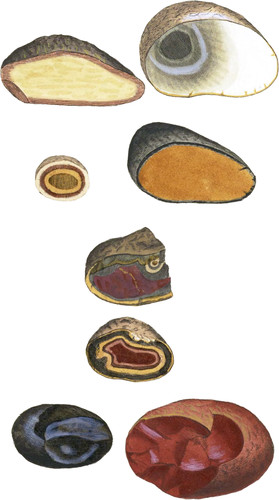 Enlarge
Enlarge
British Mineralogy
Flint Pebbles, &c
- Class 2. Earths.
- Order 1. Homogeneous.
- Gen. 4. Silex.
- Spec. 1. Quartz.
- Div. 3. Amorphous.
- Syn.
- Flint. Kirw. v. 1. 301.
- Feuer Stein. Emmerl. v. 1. 143.
- Quartz agathe pyromaque. Haüy, v. 2. 427.
Flint pebbles, so universally known in the vicinity of London, are not so well known every where, even in Great Britain, since one may travel many miles in some counties without finding any.
The forms and colours of common flints are extremely various, and they give strong indications of being formed by infiltration and aggregation among the softer argillaceous rocks; as the agates, &c. seem to be among the harder rocks of a similar nature; see p. 170: the siliceous infiltration being more or less coloured by oxide of iron, gravitates, or aggregates, into various forms.
The upper pebble at the right hand is white at one end, gradually becoming grayer towards the other end, with a line or two of interruption, and at length assuming the colour and texture of common gray flint*. The coloured part is sometimes less indurated, but insoluble in acid, and seems only destitute of the colouring matter. The coat appears to have been formed when the process was nearly complete; as drops of coloured water, or turpentine, will, in general, form a margin in the same manner on substances on which they are put: the others seem formed in a similar way, varying as to regularity. An approach to yellow, with a border of dull crimson, is seen in the next stone, and the coat is nearly black with very little variety.
The next right hand figure was given me by a friend who found it near Norwich. It is remarkable for the uniformity of the ochraceous tint all through it, and the dark coat penetrating it in the cracks, which seems to confirm the idea of the margin being formed as the substance was beginning to harden. The next stone is very regularly formed. In this, one of the circles is of as true a yellow, and nearly as bright, as I have ever found in flints. The faces of broken flints sometimes become of a brighter yellow when they have been exposed to the air. The upper central one is more irregular, but is in the middle as bright a cinnabar, or vermilion, as can perhaps be found in these sort of stones, and resembles red jasper. The fragment beneath has been irregularly modified. It is of the brightest crimson in the centre. The lower left hand figure is uniformly of a red jasper colour, which is not very frequent. Its fracture shows it not to be so tough and hard has jasper. This is rather partially covered with an ochraceous hue. The grey and black flints are not very rare: they are mostly found in wet clayey places, and are often very black, sometimes shining, or blotched with grey or a whitish hue; and, when so, are mostly lighter within under the black outside, and darker under the grey outside.
Pebbles, if of a fine ochrey hue, from the size of a horse-bean to that of a Windsor-bean, are used for making footways or walks in our best gardens; and are sold in the vicinity of London from 10 to 12 shillings per load, under the name of gravel; the coarser sort are used to mend the roads†.
They are often useful, as at Sandown Castle, near Deal, to defend the coast from the encroaching ocean. They are certainly of more use than they are imagined to be in agriculture‡; and protect the vegetable earth from the violence of the high winds, while they retain the night-fallen dews and moisture necessary for vegetation. They also defend the roots from the too sudden and scorching heat of the sun in the day. They seem admirably suited for this purpose, as their texture is such as to imbibe heat rather slowly. Thus their being common is a happy providence, and it is very reasonable to suppose that every pebble has its destined use.
A great deal more might be mentioned respecting their utility in agriculture; but if what has been said is attended to, it will be found sufficient in this place. We may observe that, when free from flaws and of a good colour, they will bear cutting, engraving, and polishing, as well as the oriental carnelians, which they partly resemble in their shining fracture, and almost equal hardness.
- * The common ingredients are
100 Silex 80 Argil 18 Lime 2 - † It might be observed that they should not be brought from the damp pits in which they are found to sudden heat or cold, as it makes them rotten, unless intended to be rendered so for manure.
- ‡ Soil may be amended by the judicious farmer by adding or diminishing their quantity according to what he wishes to cultivate; their composition, size, sponginess, softness, hardness, and even shape, are of much consequence.

